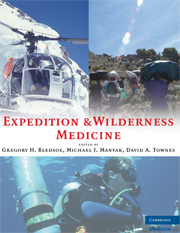Book contents
- Frontmatter
- Contents
- Contributors
- Foreword
- Preface
- Acknowledgments
- PART I EXPEDITION PLANNING
- 1 The Expedition Physician
- 2 Assessing Expedition Medical Needs
- 3 Expedition Medical Kit
- 4 Immunizations
- 5 Legal Considerations during Expedition Planning
- 6 Travel Safety
- 7 Nutritional Support for Expeditions
- 8 Water Treatment
- 9 Special Considerations
- 10 Communications Planning for the Expedition Medical Officer
- 11 Minimizing Risk on an Expedition
- 12 The Expedition Returns
- PART II EXPEDITIONS IN UNIQUE ENVIRONMENTS
- PART III ILLNESS AND INJURIES ON EXPEDITIONS
- APPENDIX The Expedition Medical Kit
- Index
3 - Expedition Medical Kit
from PART I - EXPEDITION PLANNING
Published online by Cambridge University Press: 05 March 2013
- Frontmatter
- Contents
- Contributors
- Foreword
- Preface
- Acknowledgments
- PART I EXPEDITION PLANNING
- 1 The Expedition Physician
- 2 Assessing Expedition Medical Needs
- 3 Expedition Medical Kit
- 4 Immunizations
- 5 Legal Considerations during Expedition Planning
- 6 Travel Safety
- 7 Nutritional Support for Expeditions
- 8 Water Treatment
- 9 Special Considerations
- 10 Communications Planning for the Expedition Medical Officer
- 11 Minimizing Risk on an Expedition
- 12 The Expedition Returns
- PART II EXPEDITIONS IN UNIQUE ENVIRONMENTS
- PART III ILLNESS AND INJURIES ON EXPEDITIONS
- APPENDIX The Expedition Medical Kit
- Index
Summary
Medical kits serve two basic functions: to provide transportable medical provisions and convenience in case of emergencies. From early history, evidence of medical kits can be found in archeology sites. Trajan's Column in Rome depicts scenes of wounded soldiers being treated by their fellow soldiers, an event that would require access to transported accessible supplies. Over the past 50 years, journal articles have discussed emergency medical kits for physicians or other health care professionals to use in their offices or during travel. Kits for professional or lay use have been advocated for emergency medical treatment in special circumstances such as foreign travel, in-flight emergencies, and wilderness expeditions.
Multiple factors impacting upon the design of a medical kit for remote area expedition use are indicated in Table 3.1. These basic factors have been described in the Wilderness Medical Society Practice Guidelines for Wilderness Emergency Care.
PURPOSE OF THE TRIP
Focusing upon the expedition goals and understanding the mission of the trip is the most basic requirement that needs to be clarified when designing a medical kit (Figure 3.1). If the group intends on only managing injuries and illness that will be encountered by expedition participants, then an analysis of those potential disorders will influence the kit content and quantity of materials. As quoted in the Practice Guidelines: “Because a search and rescue (SAR) team must be equipped to handle the medical emergencies that they expect to encounter, they can justify carrying specialized medical gear.
- Type
- Chapter
- Information
- Expedition and Wilderness Medicine , pp. 30 - 39Publisher: Cambridge University PressPrint publication year: 2008



